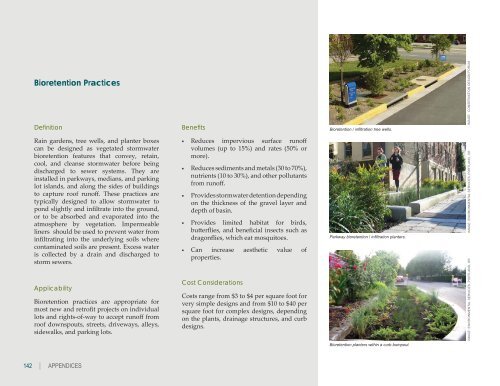design elements - San Jacinto Texas Historic District
design elements - San Jacinto Texas Historic District
design elements - San Jacinto Texas Historic District
You also want an ePaper? Increase the reach of your titles
YUMPU automatically turns print PDFs into web optimized ePapers that Google loves.
Bioretention Practices<br />
Defi nition<br />
Rain gardens, tree wells, and planter boxes<br />
can be <strong>design</strong>ed as vegetated stormwater<br />
bioretention features that convey, retain,<br />
cool, and cleanse stormwater before being<br />
discharged to sewer systems. They are<br />
installed in parkways, medians, and parking<br />
lot islands, and along the sides of buildings<br />
to capture roof runoff . These practices are<br />
typically <strong>design</strong>ed to allow stormwater to<br />
pond slightly and infi ltrate into the ground,<br />
or to be absorbed and evaporated into the<br />
atmosphere by vegetation. Impermeable<br />
liners should be used to prevent water from<br />
infi ltrating into the underlying soils where<br />
contaminated soils are present. Excess water<br />
is collected by a drain and discharged to<br />
storm sewers.<br />
Applicability<br />
Bioretention practices are appropriate for<br />
most new and retrofi t projects on individual<br />
lots and rights-of-way to accept runoff from<br />
roof downspouts, streets, driveways, alleys,<br />
sidewalks, and parking lots.<br />
142 │ APPENDICES<br />
Benefi ts<br />
■<br />
■<br />
■<br />
■<br />
■<br />
Reduces impervious surface runoff<br />
volumes (up to 15%) and rates (50% or<br />
more).<br />
Reduces sediments and metals (30 to 70%),<br />
nutrients (10 to 30%), and other pollutants<br />
from runoff .<br />
Provides stormwater detention depending<br />
on the thickness of the gravel layer and<br />
depth of basin.<br />
Provides limited habitat for birds,<br />
butt erfl ies, and benefi cial insects such as<br />
dragonfl ies, which eat mosquitoes.<br />
Can increase aesthetic value of<br />
properties.<br />
Cost Considerations<br />
Costs range from $3 to $4 per square foot for<br />
very simple <strong>design</strong>s and from $10 to $40 per<br />
square foot for complex <strong>design</strong>s, depending<br />
on the plants, drainage structures, and curb<br />
<strong>design</strong>s.<br />
Bioretention / infi ltration tree wells.<br />
Parkway bioretention / infi ltration planters.<br />
Bioretention planters within a curb bumpout.<br />
IMAGE: CONSERVATION DESIGN FORUM<br />
IMAGE: ENVIRONMENTAL SERVICES, PORTLAND, OR IMAGE: ENVIRONMENTAL SERVICES, PORTLAND, OR


